The Return of the Hand-Painted Sign
Hand-painted signs are making a comeback, but are they the work of artists or “mechanics”?
![]()
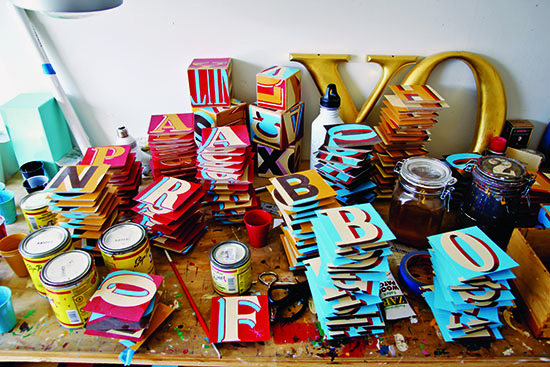
Jeff Canham’s painted letters (image: Princeton Architectural Press)
Last fall, I went on a reporting road trip through the American South. Eating was not the main purpose of the trip, but the need to find food along the road between North Carolina, Georgia, Tennessee, and Louisiana provided a great secondary mission. As a guide, we relied on Garden & Gun magazine’s list of the 50 Best Southern Foods. I referenced it time and again during the trip, and the image that accompanied each page became like a visual symbol of the journey.

Hand-lettered chalk sign by Dana Tanamachi for Garden & Gun magazine (danatanamachi.com)
A few months later, that familiar picture reappeared while I was scanning some design blogs, and only then did it occur to me that the image was a hand-painted sign (or hand-chalked, in this case). The artist, Dana Tanamachi, had posted a 2-minute time-lapse video on the making of the piece. Despite having put little thought into the graphic back when I was looking at the content, I realized then that the authentic, folksy (you could say “Southern”) feel of the food guide resulted largely from the presence of the handmade sign. The magazine could have used computer graphics, could even have rendered something digitally to appear hand-drawn, but instead they chose the real thing, and it made the whole production that much more engaging and memorable.
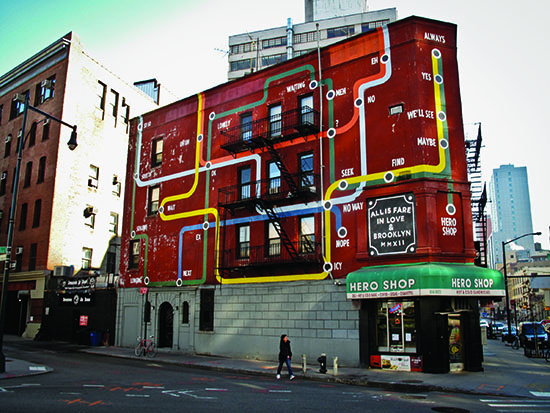
“Train to Always,” by Stephen Powers. Brooklyn, NY 2012 (image: Princeton Architectural Press)
Sign painting as an occupation and industry took a major hit with the advent of illustration software, giant printers, and vinyl cutting, but it’s making a comeback thanks to our cultural reinvestment in the value of manual work. Books like Shop Class as Soulcraft and Handmade Nation shone spotlights on the growing movement of makers taking handiwork back from hobby to livelihood. Now the author of Handmade Nation, Faythe Levine, has a new book (and documentary) that zeroes in on the world of professional sign painters. In collaboration with Sam Macon, Levine visited two dozen people who have made their mark on food trucks, shop windows, billboards, and multi-story buildings across the country. Sign Painters, published by Princeton Architectural Press, features the painters in their own words and incredibly bold images, describing how they came to this profession and how things have changed.
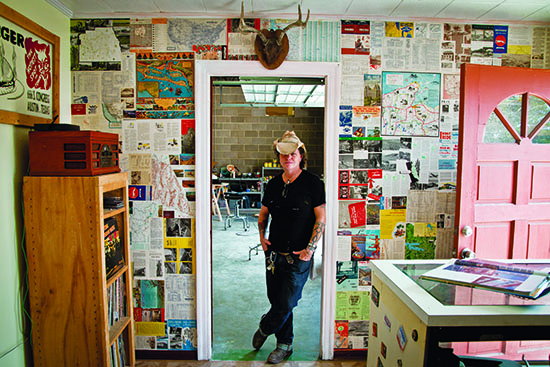
Sign painter Norma Jeanne Maloney in her studio in Austin, TX (image: Princeton Architectural Press)
A common thread among the subjects of the book is that while what they are producing is art, most don’t call themselves artists. “The kind of sign painting that I embrace, that I make a living doing,” says Cincinnati-based Justin Green, “is a service. It’s an industry, and I want to keep it that way…when the unions held sway, ‘artist’ was a pejorative term. In all the old sign-painting books the sign painter was referred to as the ‘mechanic.’” Phil Vandervaart (painter of the Dusty’s Bar sign, below) echoes the sentiment: “It’s a sign, not fine art,” he says,”It’s meant to convey information and be attractive.” For Vandervaart, sign painting is a way of “adding to the urban cacophony” and impacting the cityscape. it’s a description that could almost as easily refer to graffiti, and indeed some of the painters came from a street art background, but the role of sign painting as marketing device is not lost on the people who aim to earn a living through this work. Keith Knecht, who was featured in the book at age 71 and passed away before its release, points to sign painters as the original brand identity developers for companies. “In 1840 there weren’t big advertising agencies on Madison Avenue designing logos and creating campaigns,” he says, “Sign painters designed those logos.”
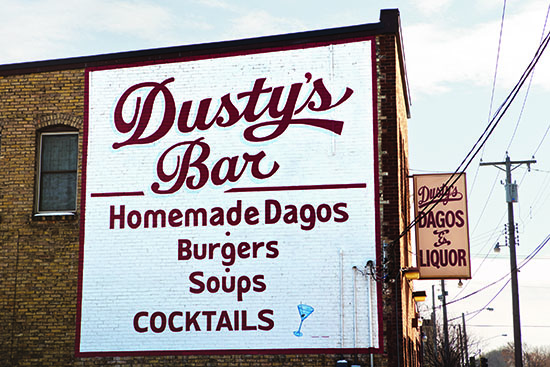
Phil Vandervaart, Minneapolis, MN (image: Princeton Architectural Press)
Surprisingly, not all of the painters eschew computers, though they don’t choose to produce their work exclusively on the screen (and some do lament that computers have caused the deterioration of basic artistic skills, and a fervent need for speed and replication). Gary Martin, an Austin, Texas-based sign painter who has been making signs since the ’70s, enjoys the visibility the Internet enables, and finds fresh motivation through the younger generation of sign painters who are connecting and showing their work online. “I feel like I’ve been living on a desert island by myself for years and then all of a sudden a bunch of other young people show up to join me,” he says, “Now I can post my stuff online and get reactions from other sign painters.” One of those younger painters is San Francisco-based Jeff Canham (whose letters are featured at the top of the post). Canham has had a hybrid career, straddling the physical and digital, advertising and fine art. “I don’t know where you draw the line between one and the other,” he remarks, “Just about everything I do has some kind of combination of hand painted and digitally rendered…I wasn’t necessarily hell-bent on doing everything by hand. I was bored with the computer.”
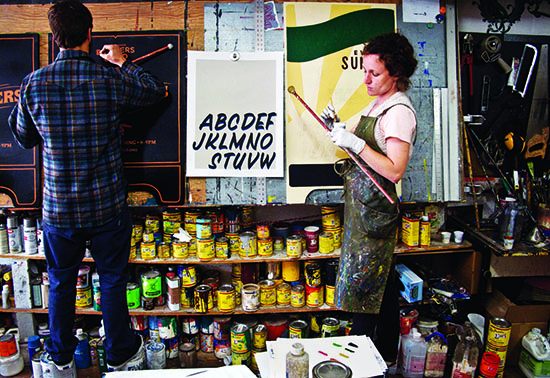
Caitlyn Galloway in the studio, San Francisco (image: Princeton Architectural Press)
Canham is among a handful of painters featured in the book who have passed at one time or another through the workshop of New Bohemia Signs in San Francisco. Frequent mentions of the place, as well as sign schools in Los Angeles, Denver, and elsewhere, make clear that sign painting is a trade that values mentorship, apprenticeship and lineage. Like all designers, sign painters look to their predecessors to guide them on technique and tradition, while picking and choosing from the modern tools available now. Sign Painters is a great source of inspiration about this often-overlooked industry, and a good reminder to pay a little extra attention while out in the city, on the highway, or wherever. Beautiful hand-painted signs are everywhere.
/https://tf-cmsv2-smithsonianmag-media.s3.amazonaws.com/accounts/headshot/sarah-rich-240.jpg)
/https://tf-cmsv2-smithsonianmag-media.s3.amazonaws.com/accounts/headshot/sarah-rich-240.jpg)